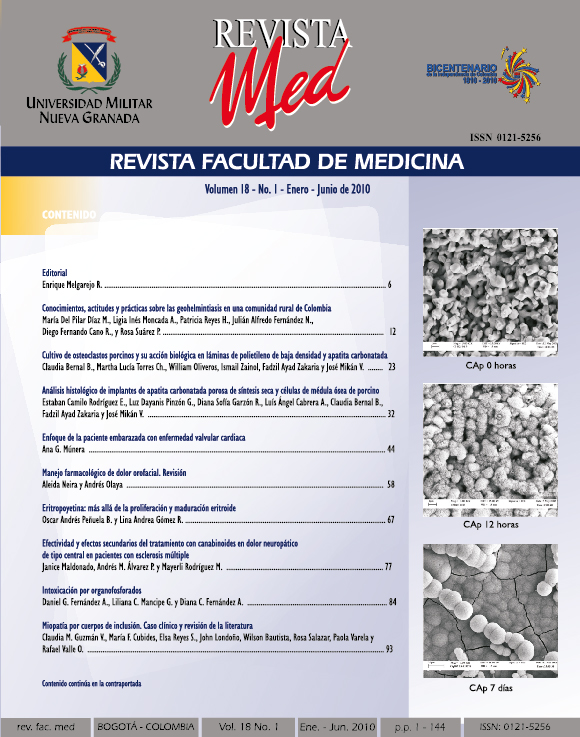Manejo farmacológico de dolor orofacial. Revisión
Resumen
El dolor orofacial en sus fases aguda y crónica, sea somático de etiología neuropática, o asociado a condiciones psicológicas, tiene una alta prevalencia en nuestro medio. Múltiples opciones terapéuticas de tipo farmacológico se convierten en la primera línea de tratamiento y la correcta elección depende de la patología subyacente. Esta decisión no siempre se facilita debido a que no existe unidad en cuanto a los criterios diagnósticos para su clasificación. Teniendo en cuenta la multiplicidad de opciones, el objetivo de la presente revisión es analizar los tratamientos descritos en la literatura científica actual, con el propósito de brindar elementos que faciliten tomar una decisión certera en cada caso específico de dolor orofacial.
Descargas
Lenguajes:
esReferencias bibliográficas
Navarro C. Tratado de Cirugía Oral y Maxilofacial. 2007; Tomo I. Cap 21.
Koopman J, Dieleman J P, Huygen F J, De Mos C, Sturkenboom M. Incidence of Facial Pain in the General Population. International Association for the Study of Pain. 2009;147:122–127.
Sarlani E, Balciunas B, Grace E. Assessment and Management of Musculoskeletal and Neuropathic Causes. AACN Clinical Issues. 2005;16(3):333–346.
Riley J L, Gilbert G. Orofacial Pain Symptoms: An Interaction between Age and Sex. Pain. 2001;90:245-256.
Fischer D, Klasser G, Epstein J. Cancer and Orofacial Pain. Oral Maxillofacial. Surgical Clinics of North America. 2008;20:287–301.
Moore L. Evaluation of the Patient for Temporomandibular Join Surgery. CAN. 2006; 18 291–303.
Okeson J. The Classification of Orofacial Pains. Oral and Maxillofacial Surgery Clinics of North America. 2008;20:133–144.
Carlson C R. Psychological Considerations for Chronic Orofacial Pain. Oral and Maxillofacial Surgery Clinics of North America. 2008;20:185–195.
Vernon H, Schneider M. Chiropractic Management of Myofascial Trigger Points and Myofascial Pain Syndrome: A Systematic Review Of The Literature. Journal of Manipulative and Physiological Therapeutics Vernon and Schneider. 2009;32(1):14-24.
Perez S, Oliván B, Arnal A, Mayoral O. Contributions of Myofascial Pain in Diagnosis and Treatment of Shoulder Pain: A Randomized Control Trial. BMC Musculoskeletal Disorders. 2009;10(92):1-7.
Manolopoulos L, Vlastarakos P V, Georgiou L, Giotakis I, Loizos A, Nikolopoulos T. Myofascial Pain Syndromes in the Maxillofacial Area: A Common but Underdiagnosed Cause of Headand Neck Pain. International Journal of Oral and Maxillofacial Surgery. 2008;37:975–984.
Prithvi P, Paradise L A. Myofascial Pain Syndromeand Its Treatment in Low Back Pain. Seminars in Pain Medicine. 2004;2:167-174.
Benoliel R, Birman N, Eliav E, Sharav Y. The International Classification of Headache Disorders: Accurate Diagnosis of Orofacial Pain? Cephalalgia. 2008;28:752–762.
Hersh E V, Balasubramaniam R, Pinto A. Pharmacologic Management of Temporomandibular Disorders. Oral and Maxillofacial Surgery Clinics of North America. 2008;20:197–210.
Mercuri L G. Osteoarthritis, Osteoarthrosis, and Idiopathic Condylar Resorption. Oral and Maxillofacial Surgery Clinics of North America. 2008;20:169–183.
Lewis M A, Sankar V, De Laat A, Benoliel R. Management of Neuropathic Orofacial Pain. Oral Surgery, Oral Medicine, Oral Pathology, Oral Radiology, and Endodontology. 2007;103(1):S32.e1-24.
Benoliel R, Eliav E. Neuropathic Orofacial Pain. Oral and Maxillofacial Surgery Clinics of North America. 2008;20:237–254.
Nixdorf D R, Velly A M, Alonso A A. Neurovascular Pains: Implications of Migraine for the Oral and Maxillofacial Surgeon. Oral and Maxillofacial Surgery Clinics of North America. 2008;20:221–235.
Clark G T. Classification, Causation and Treatment of Masticatory Myogenous Pain and Dysfunction. Oral and Maxillofacial Surgery Clinics of North America. 2008;20:145–157.
Scrivani S J, Mathews E S, Maciewicz R J. Trigeminal Neuralgia. . Oral Surgery, Oral Medicine, Oral Pathology, Oral Radiology, and Endodontology. 2005;100:527-538.
Sato J, Saitoh T, Notani K, Fukuda H, Kaneyama K, Segami N. Diagnostic Significance of Carbamazepine and Trigger Zones in Trigeminal Neuralgia. Oral Surgery Oral Medicine Oral Pathology. 2004;97:18-22.
Mounsey A L, Matthew L G, Slawson D C. Herpes Zoster And Postherpetic Neuralgia: Prevention and Management. American Academy of Family Physicians. 2005;72(6):1075-1080.
Arias M. ¿Es la Fibromialgia una Enfermedad Neurológica? Servicio de Neurología Complexo Hospitalario Universitario Santiago de Compostela (La Coruña). Neurología. 2008;23(9):593-601.
Ubago M C, Ruiz I. Analysis of the Impact of Fibromyalgia on Quality of Life: Associated Factors. Clinical Rheumatology. 2008;27:613-619.
Lera S, Gelman S, López M J, Abenoza M, Zorrilla J G, Castro J, Salamero M. Multidisciplinary Treatment of Fibromyalgia: Does Cognitive Behavior Therapy Increase the Response to Treatment? Journal of Psychosomatic Research. 2009;67:433–441.
Zapata A L, Pantoja A J. Pain and Musculoskeletal Pain Syndromes in Adolescents. Journal of Adolescent Health. 2006;38:769–771.
Pérez-Pareja J, Borrás C, Sesé A. Percepción de Dolor y Fibromialgia. Actas Españolas de Psiquiatria. 2005;33(5):303-310.
González J L, Peñacoba C, Velasco L, López A. Mercado F, Barjola P. Recursos Cognitivos de Percepción de Control, Procesos de Estrés/Recuperación y Malestar Afectivo en Fíbromialgia. Psicothema. 2009;21(3):359-368.
Cummings M, Baldry P. Regional Myofascial Pain: Diagnosis and Management. Best Practice and Research Clinical Rheumatology. 2007;21(2):367-387.
Ruiz M, Nadador V, Fernández J, Hernández J. Dolor de Origen Muscular: Dolor Miofascial y Fibromialgia. Revista de la Sociedad Española del Dolor. 2007;1:36-44.
Malchow R J, Black I H. The Evolution of Pain Management in the Critically Ill Trauma Patient: Emerging Concepts from the Global War on Terrorism. Critical Care Medicine. 2008;36(7):346-357.
Zuniga J R, Ibanez C, Kozacko M. The Analgesic Efficacy and Safety of Intra-Articular Morphine and Mepivicaine Following Temporomandibular Joint Arthroplasty. Journal of Oral and Maxillofacial Surgery. 2007;65:1477-1485.
Hammonds B, Sidebotham D, Anderson B J. Aspects of Tramadol and Ondansetron Interactions. Acute Pain. 2003;5:31-34.
Strumpf M, Kulka P, Zenz M. Efficacy and Safety of Tramadol and Morphine in Patients with Extremely Severe Postoperative Pain. Acute Pain. 2000;3(3):1-7.
Tuzuner A M, Ucok C, Kucukyavuz Z, Alkis N, Alanoglu Z. Preoperatıve Diclofenac Sodium and Tramadol for Pain Relief After Bimaxillary Osteotomy. Journal of Oral and Maxillofaccial Surgery. 2007;65:2453-2458.
Bennett R, Karim K. Tramadol and Acetaminofen Combination Tablets in the Treatment of Fibromyalgia Pain: A Double-blind, Randomized, Placebo-Controlled Study. The American Journal of Medicine. 2003;114:537-545.
Pagliara L, Tornago S. Tramadol Compared with Diclofenac in Traumatic Musculoskeletal Pain. Current Therapeutic Research. 1997;58(1):473-480.
Podolecki T, Podolecki A, Hrycek A. Fibromyalgia: Pathogenetic, Diagnostic and Therapeutic Concerns. Polskie Archiwum Medycyny Wewnetrznej. 2009;119(3):157-161.
Willoughby DA, Moore AR, Colville-Nash PR. COX-1, COX-2, and COX-3 and the future treatment of chronic infl ammatory disease. Lancet 2000; 355:646–48.
Habib A and Gan T. Role of Analgesic Adjuncts in Postoperative Pain Management. Anesthesiology Clinics of North America. 2005;23:85-107.
Forbes A B. A Regional Audit of the Use of COX-2 Selective Non- Steroidal Anti-Inflammatory Drugs (NSAIDs) in Rheumatology Clinics in the West Midlands, In Relation to NICE Guidelines. Rheumatology. 2005;44:921–924.
González-Escalada J R, Rodríguez M J, Camba M A, Portolés A, López R. Recomendaciones para el Tratamiento del Dolor Neuropático. Revista de la Sociedad Española del Dolor. 2009;16(8):445-67.
Jung J, Kim D K, Kim M, Kim H J. Onset of Analgesia and Analgesic Efficacy of Tramadol/Acetaminophen and Codeine/ Acetaminophen/Ibuprofen in Acute Postoperative Pain: A Single-Center, Single-Dose, Randomized, Active-Controlled, Parallel-Group Study in a Dental Surgery Pain Model. Clinical Therapeutics. 2004;26(7):1037-1045.
Joshia A, Pararab E, Macfarlane T V. A Double-blind Randomized Controlled Clinical trial of the Effect of Preoperative Ibuprofen, Diclofenac, Paracetamol with Codeine and Placebo Tablets for Relief of Postoperative Pain after Removal of Impacted Third Molars. The British Association of Oral and Maxillofacial Surgeons. 2004;42:299-306.
Savage M G, Henry M A, Colo D. Preoperative Nonsteroidal Antiinflammatory Agents: Review of the Literature. Oral Surgery, Oral Medicine, Oral Pathology, Oral Radiology, and Endodontology. 2004;98:146-52.
Malley P, Balden E, Tomkins G. Treatment of Fibroyalgia with Antidepressants. Journal of General of Internal Medicine. 2000;15:659-666.
Kurtoglu C, Gur H, Kurkcu M, Sertdemir Y, Guler-Uysal F, Uysal H. Effect of Botulinum Toxin-A in Myofascial Pain Patients with or without Functional Disc Displacement. Journal of Oral and Maxillofacial Surgery. 2008;66:1644-1651. 48. Lang A M. A Preliminary Comparison of the Efficacy and Tolerability of Botulinum Toxin Serotypes A and B in the Treatment of Myofascial Pain Syndrome: A Retrospective. Open-Label Chart Review, Clinical Therapeutics. 2003;25(8):2268-2278.
Gobel H, Heinze A, Reichel G, Hefter H, Benecke R. Efficacy and Safety of a Single Botulinum Type A Toxin Complex Treatment (Dysport) for the Relief of Upper Back Myofascial Pain Syndrome: Results from a Randomized, Results from a randomized double-blind placebo-controlled multicentre study. Pain. 2006;125:82-88. 50. Balasubramaniam R, Ram S. Orofacial Movement Disorders. Oral and Maxillofacial Surgery Clinics of North America. 2008;20:273–285.
Jeffrey P O. Management of Temporomandibular Disorders and Occlusion. Mosby. 2008; 6° edición.
Katzung B G. Farmacología Basica y Clinica. 2007. 10° edicion.
Gonima E. Guías de Manejo del Dolor. Hospital Militar Central. 2009.
Phero J C, Becker D E, Dionne R A. Contemporary Trends in Acute Pain Management. Current Opinion in Otolaryngology and Head and Neck Surgery. 2004;12:209-216.
Prasad A, Galetta S. Trigeminal Neuralgia Historical Notes and Current Concepts. The Neurologist. 2009;15:87-94.







.png)





